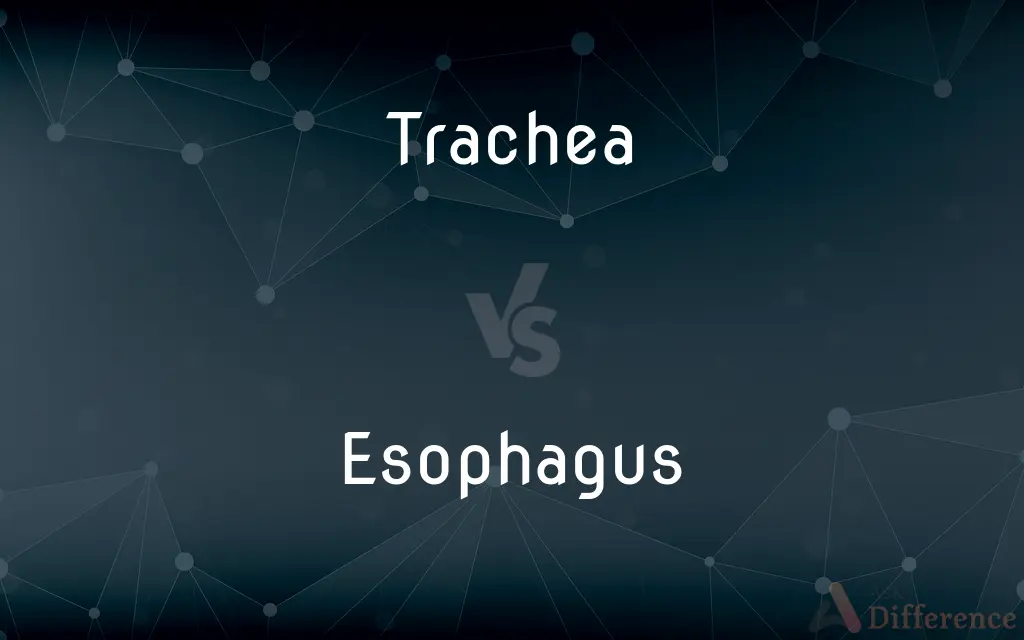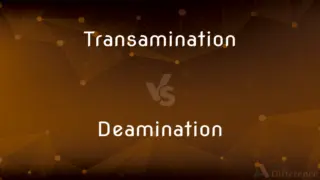Trachea vs. Esophagus — What's the Difference?
By Maham Liaqat & Fiza Rafique — Updated on April 14, 2024
The trachea, also known as the windpipe, carries air to the lungs, while the esophagus transports food and liquids to the stomach.

Difference Between Trachea and Esophagus
Table of Contents
ADVERTISEMENT
Key Differences
The trachea is a rigid tube located in the front part of the neck, leading air into the lungs, whereas the esophagus is a muscular tube behind the trachea that conveys food and liquids from the mouth to the stomach.
The trachea is fortified by C-shaped cartilaginous rings that keep it perpetually open for air passage, while the esophagus has a flexible, muscular wall that can expand and contract to push food towards the stomach.
The trachea is lined with ciliated epithelium, which helps trap and expel dust and other particles from the airway, whereas the esophagus is lined with smooth epithelial cells that produce mucus to ease the passage of food.
In terms of function, the trachea is part of the respiratory system, crucial for breathing, while the esophagus belongs to the digestive system, essential for the transportation of food and liquids.
Disorders of the trachea often involve respiratory issues such as bronchitis or tracheitis, while esophageal disorders typically relate to digestion, such as acid reflux or esophageal cancer.
ADVERTISEMENT
Comparison Chart
Location
In front of the neck
Behind the trachea in the neck and chest
Function
Air passage to the lungs
Food and liquid passage to the stomach
Structural Support
C-shaped cartilaginous rings
Muscular, flexible walls
Lining
Ciliated epithelium
Smooth epithelial cells with mucus
System
Respiratory
Digestive
Compare with Definitions
Trachea
Protected by cartilage rings.
The cartilage rings prevent the trachea from collapsing.
Esophagus
Prone to acid reflux.
Acid reflux occurs when stomach acid irritates the esophagus.
Trachea
A tube that conducts air to and from the lungs.
During surgery, the doctor intubated the patient's trachea to maintain airflow.
Esophagus
Transports food from the throat to the stomach.
Swallowed food passes down the esophagus to reach the stomach.
Trachea
Located in the neck.
A tracheotomy is a procedure that opens the trachea through the neck.
Esophagus
Not supported by cartilage.
Unlike the trachea, the esophagus can expand as large pieces of food pass through.
Trachea
Essential for breathing.
The trachea must remain unobstructed for effective respiration.
Esophagus
Muscular and contractile.
The esophagus uses peristalsis to push food toward the stomach.
Trachea
Lined with cells that have cilia.
The cilia in the trachea help filter out dust and pollutants.
Esophagus
Covered with mucus-producing cells.
The mucus in the esophagus helps protect its lining from abrasion.
Trachea
The trachea, also known as the windpipe, is a cartilaginous tube that connects the larynx to the bronchi of the lungs, allowing the passage of air, and so is present in almost all air-breathing animals with lungs. The trachea extends from the larynx and branches into the two primary bronchi.
Esophagus
The muscular tube by which food passes from the pharynx to the stomach; the gullet.
Trachea
(Anatomy) A thin-walled, cartilaginous tube descending from the larynx to the bronchi and carrying air to the lungs. Also called windpipe.
Esophagus
(American spelling) oesophagus
Trachea
(Zoology) One of the internal respiratory tubes of insects and some other terrestrial arthropods, which are connected to the spiracles and are used for gas exchange.
Esophagus
That part of the alimentary canal between the pharynx and the stomach; the gullet. See Illust. of Digestive apparatus, under Digestive.
Trachea
(Botany) A tracheary element.
Esophagus
The passage between the pharynx and the stomach
Trachea
(anatomy) A thin-walled, cartilaginous tube connecting the larynx to the bronchi.
Trachea
The xylem vessel.
Trachea
(entomology) One of the cuticle-lined primary tubes in the respiratory system of an insect, which extend throughout its body.
Trachea
The windpipe. See Illust. of Lung.
Trachea
One of the respiratory tubes of insects and arachnids.
Trachea
One of the large cells in woody tissue which have spiral, annular, or other markings, and are connected longitudinally so as to form continuous ducts.
Trachea
Membranous tube with cartilaginous rings that conveys inhaled air from the larynx to the bronchi
Trachea
One of the tubules forming the respiratory system of most insects and many arachnids
Common Curiosities
What is the main function of the trachea?
To provide a clear airway to the lungs.
Can both the trachea and esophagus expand?
The trachea remains rigid, while the esophagus can expand.
What is the main function of the esophagus?
To transport food and liquids to the stomach.
What type of cells line the trachea?
Ciliated epithelial cells.
Are there cartilages in the esophagus like in the trachea?
No, the esophagus does not have cartilaginous support.
How do problems in the trachea affect breathing?
They can obstruct or reduce airflow, causing respiratory difficulty.
What are common disorders associated with the esophagus?
Acid reflux and esophageal cancer.
How does the esophagus move food to the stomach?
Through muscular contractions known as peristalsis.
How do the trachea and esophagus interact in the body?
They are parallel structures in the neck but serve different systems.
How does the body prevent food from entering the trachea?
The epiglottis covers the trachea during swallowing.
What type of cells line the esophagus?
Smooth epithelial cells with mucus.
How do problems in the esophagus affect digestion?
They can impede or cause painful passage of food to the stomach.
What are common disorders associated with the trachea?
Bronchitis and tracheitis.
What happens if food enters the trachea?
It can cause choking and respiratory distress.
What is the significance of the trachea's cartilaginous rings?
They keep the airway open regardless of pressure changes during breathing.
Share Your Discovery

Previous Comparison
Mixing vs. Mastering
Next Comparison
Transamination vs. DeaminationAuthor Spotlight
Written by
Maham LiaqatCo-written by
Fiza RafiqueFiza Rafique is a skilled content writer at AskDifference.com, where she meticulously refines and enhances written pieces. Drawing from her vast editorial expertise, Fiza ensures clarity, accuracy, and precision in every article. Passionate about language, she continually seeks to elevate the quality of content for readers worldwide.















































